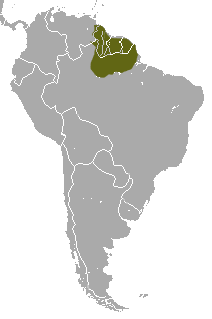Red-faced spider monkey
| Red-faced spider monkey | ||||||||||||
|---|---|---|---|---|---|---|---|---|---|---|---|---|

Red-faced spider monkey ( Ateles paniscus ) |
||||||||||||
| Systematics | ||||||||||||
|
||||||||||||
| Scientific name | ||||||||||||
| Ateles paniscus | ||||||||||||
| ( Linnaeus , 1758) |
The red-faced spider monkey ( Ateles paniscus ) is a species of primate from the family of spider- tailed monkeys (Atelidae) that lives in northeastern South America . It was formerly combined with the black- faced spider monkey to form a common species, the black spider monkey.
features
Red-faced spider monkeys are among the largest representatives of spider monkeys . They reach a head body length of up to 63 centimeters, the tail is longer than the body and can measure up to 80 centimeters. At around 11 kilograms, males are slightly heavier than females, who can reach around 9.5 kilograms. Your physique is slim, the limbs are very long and thin. The hands are hook-shaped, the thumb has receded. The long tail is designed as a grasping tail, it is hairless at the rear end on the underside. The fur is black, the eponymous feature is the reddish, hairless face.
distribution and habitat
Red-faced spider monkeys live in northeastern South America. Their distribution area includes Guyana , Suriname , French Guiana and northeastern Brazil north of the Amazon . Their habitat is forests, especially rainforests .
Lifestyle and diet
These primates are tree-dwellers who mainly reside in the upper canopy. Like all spider monkeys, they are diurnal. They are fast and skilled climbers who move on all fours or swinging and swinging. They use the prehensile tail like a limb. They can also hang by just one limb or tail, for example when foraging for food.
They live in groups of around 20 to 30 animals, which mostly split up into smaller subgroups during their daily foraging and come together again to sleep. Loud screams serve, on the one hand, to draw the attention of animals from outside the group to their own whereabouts, and on the other hand to maintain contact between the subgroups.
Red-faced spider monkeys feed primarily on fruits. To a lesser extent, they also consume leaves and other parts of plants.
Reproduction
Most births occur in the rainy season between November and February. Then the female gives birth to a single young after a gestation period of around 7.5 months. This is weaned after about a year, and sexual maturity occurs at three to four years of age.
Danger
Red-faced spider monkeys depend on intact primary forests and are therefore sensitive to human disturbances. In addition to the destruction of the habitat, the main danger is hunting for their meat. These factors are exacerbated by the very low reproduction rate. Overall, the species is listed as endangered ( vulnerable ) by the IUCN .
literature
- Thomas Geissmann : Comparative Primatology. Springer-Verlag, Berlin a. a. 2003, ISBN 3-540-43645-6 .
- Don E. Wilson, DeeAnn M. Reeder (Eds.): Mammal Species of the World. A taxonomic and geographic Reference. Johns Hopkins University Press, Baltimore MD 2005, ISBN 0-8018-8221-4 .

